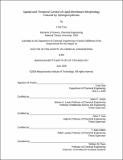Spatial and temporal control of lipid-membrane morphology induced by sphingomyelinase
Author(s)
Chao, Ling, Ph. D. Massachusetts Institute of Technology
DownloadFull printable version (23.22Mb)
Other Contributors
Massachusetts Institute of Technology. Dept. of Chemical Engineering.
Advisor
Klavs F. Jensen, Alice P. Gast and T. Alan Hatton.
Terms of use
Metadata
Show full item recordAbstract
Sphingomyelinase (SMase) has been shown to be involved in a variety of cell regulation processes. It can convert sphingomyelin (SM) to ceramide (Cer) and has been suggested to influence the cellular processes by reorganizing the cell membrane morphology. This thesis aims at a more comprehensive understanding of how sphingomyelinase (SMase) can regulate lipid membrane heterogeneity. We develop corralled model raft membranes in a microfluidic device to study the complex phase phenomena induced by SMase. The mass balance of lipid molecules in each confined corral greatly helps us to interpret results. By using the corralled membrane arrays, we are able to obtain the overall statistical distribution of the induction time of a slow domain nucleation and therefore fairly compare the membrane responses caused by different factors. In addition, the flow control by a microfluidic device solves the difficulty of distributing SMase uniformly to membrane systems. Furthermore, the laminar flow in a microchannel allows us to create model membrane arrays with a variety of lipid membrane compositions or solution conditions, which can serve as a screening tool to study a broad range of parameters associated with the interactions between lipid membranes and SMase or other peripheral proteins. We report that SMase can induce both a reaction-induced and a solvent-mediated phase transformation, causing switches of three stationary membrane morphologies and multiple-time-domain ceramide generation in model raft membranes. (cont.) During the reaction-induced phase transformation, the ceramide generated by SMase causes the disintegration of pre-existing rafts rich in sphingomyelin and cholesterol, and recruit sphingomyelin to form SM-enriched domains which are relatively inaccessible to SMase. Once most of the sphingomyelin is physically trapped in SM-enriched domains and the SM concentration in the SMase-accessible region becomes low, the morphology pauses. The pause situation is resolved after the formation of a 3-D feature, rich in SMase, sphingomyelin (SMase's substrate), and ceramide (SMase's product), which triggers the solvent-mediated phase transformation. This 3-D feature is hypothesized as a slowly nucleating SMase-enriched phase where SMase processes sphingomyelin at low concentration more efficiently. The disparate time-scales of the formation of these SMase-features and the SM-enriched domains allow for the development of a significant duration of the middle pause morphology between the two transformations. The results show that SMase can be actively involved in the lipid membrane phase changes. The SMase-induced multi-stage morphology evolution is not only due to the membrane compositional changes caused by SMase,but also due to the selective binding of SMase, and SMase's special phase behavior during the solvent-mediated phase transformation. We further demonstrate that lipid membrane composition and SMase concentration can be used to tune the two phase transformations and therefore the intervals and spatial patterns of Smase-induced multi-stage morphology evolution. (cont.) At a physiologically relevant concentration of SMase, we observe that membrane composition can influence the formation of SM-enriched domains and the nucleation of SMase-features at different extents of time scale and thus significantly tune the stable duration of the middle pause morphology. More importantly, the induction time of SMase-feature nucleation can be significantly decreased by increasing the supersaturating level of its three components in the membrane system. We further model the spatio-temporal morphology change during the solvent-mediated phase transformation. Three major kinetic processes are described in the model: the consumption of SM by the enzymatic reaction at an SMase-feature, the diffusion of SM from SM-enriched domains to an SMase-feature, and the release of SM due to the dissolution of SM-enriched domains. We combine MATLAB coding with Comsol, a software using finite element method to solve partial differential equations, to solve the model numerically due to the complex geometry and the moving boundary of our membrane systems. The non-dimensionality of the model allows the system to be characterized by three non-dimensional parameters. We show all of the possible scenarios of spatial pattern change during the phase transformation. The modeling results are shown to be consistent with our experimental results and can provide insights into the system parameters which are difficult to measure.
Description
Thesis (Ph. D.)--Massachusetts Institute of Technology, Dept. of Chemical Engineering, 2009. This electronic version was submitted by the student author. The certified thesis is available in the Institute Archives and Special Collections. Includes bibliographical references (p. 195-201).
Date issued
2009Department
Massachusetts Institute of Technology. Department of Chemical EngineeringPublisher
Massachusetts Institute of Technology
Keywords
Chemical Engineering.